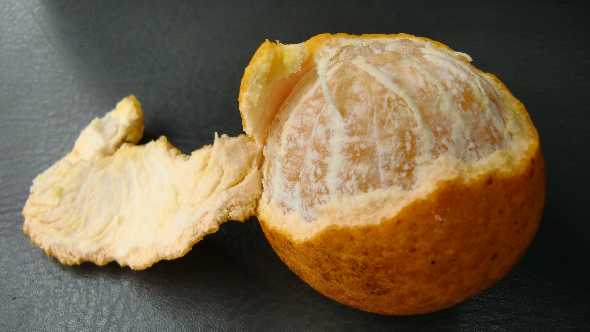Florida Citrus Breeders Squeezed For Time
The sweet orange is not only the most widely planted tree fruit worldwide; it is by far the most economically significant crop to Florida. Since the discovery of the original sweet orange, advantageous mutations have been identified, clonally propagated, and introduced. Though the list of sweet orange varieties presents a range of traits and characteristics, genetic variation of the sweet orange genome remains quite narrow. Tremendous expansion of orange plantings and the development of multiple market channels resulted in efficiencies, but also has contributed to the creation of a monoculture. Sweet orange varieties have proven particularly susceptible to HLB.

There are several new orange-like hybrids in the USDA-ARS program. Photo courtesy of USDA-ARS
Breeding sweet oranges is a complex task. Dr. Ed Stover, USDA, shared that “the process is impeded by the high degree of apomixis in sweet orange, and low survival of embryos from sexual recombination (Hearn, 1994). When true hybrids are produced from sweet orange crossed with sweet orange, they reportedly do not closely resemble sweet-orange, displaying traits more like those of mandarins (C. reticulata) or pummelos (C. maxima) (Hearn, 1977) and some breeders reported no sweet-orange-like hybrids despite several attempts (Furr, 1969). There have been some instances in which crosses not including sweet orange have produced hybrids similar to the sweet orange (Hearn, 1994).”
This causes us to wonder, what is the best tactic in developing a conventionally bred tolerant sweet orange?
Florida is blessed to have USDA and UF/IFAS citrus breeding programs employing unique approaches to the development of conventionally bred sweet oranges. Each of these programs is attacking this challenge from a different angle.
Under The Hood At USDA-ARS
USDA-ARS has placed a considerable emphasis on the development of new sweet orange-like hybrids for the past 40 years. However, in the last five years, they have selected five promising hybrids for further study. These hybrids are very orange-like in appearance, color, flavor, volatiles, and juice quality. All ripen at approximately the same time as ‘Hamlin.’ They are now planted in six diverse field trials where they will be challenged with HLB.
‘Ambersweet’ is the female parent of all five of these promising orange-like hybrids. It is most interesting to note: Though ‘Ambersweet’ has its shortfalls as a commercial variety, it has proven highly valuable as a breeding parent. ‘Ambersweet’ tends to pass along favorable juice, color, vigor, early maturity, and fairly loose skin to its progeny. Likewise, though ‘Ambersweet’ has shown no greater tolerance to HLB than sweet orange varieties, some of its offspring (including those mentioned above) appear to display greater levels of tolerance. All might have potential for processing, but one also is peelable, with potential for the fresh market. It should be mentioned that USDA has noticed heightened HLB tolerance in mandarin crosses with a clementine x ‘Orlando’ pedigree. This is particularly interesting as ‘Ambersweet’ is (clementine x ‘Orlando’) x sweet orange. With ‘Orlando’ and clementine having sweet orange in the pedigree, this certainly is a promising path.
At Work With UF/IFAS
Dr. Fred Gmitter and Dr. Jude Grosser are pursuing a number of approaches at UF/IFAS. Like their colleagues at USDA, they are trying to backcross the disease resistance genes from trifoliate orange into orange-like hybrids. They have produced the seedless C4-16-12 hybrid (1/8 trifoliate) that produces juice very similar to orange juice, and is showing reasonable tolerance to HLB (it is not resistant). The breeding team also has made additional crosses pursuing this approach.

Photo by Tyler Jones
Dr. Grosser’s favorite approach is to identify HLB-tolerant mandarin or mandarin/orange hybrids that have good juice profiles similar to orange juice, but also feature juice that will hold its flavor after not from concentrate processing. Many of the mandarins and hybrids produce tasty juice when fresh-squeezed, but the juice develops off flavors after processing. The UF/IFAS Plant Improvement Team has one such HLB-tolerant hybrid mandarin called “cybrid #304” in both the diploid and tetraploid form — with juice that can be successfully processed with no off flavors, and also that has been described as having a strong sweet orange note by a professional taste panel.
The team is using these and other similar hybrids in complementary crosses to generate triploid progeny that are expected to have higher levels of HLB tolerance in combination with good sweet orange characteristics. This will hopefully generate new cultivars that have both fresh market and processing potential.
The UF/IFAS team recently identified several ‘Valencia’ selections irradiated more than 15 years ago that have shown few or no HLB symptoms after 15 years in the field. So far, replicated individuals from these selections all are behaving the same way.
The Citrus Research and Education Center team also has produced a large number of mandarin/orange hybrids with a range of fruit quality characteristics. Some have consistently continued to produce quality fruit with flavor and aroma similar to sweet orange, but are exhibiting greater levels of HLB tolerance compared with oranges. The broad genetic base may result in enhanced tolerance. Observations are ongoing.
Further (through work with Dr. Yu Wang), the UF/IFAS Plant Improvement team is exploring in greater depth the juice quality of several mandarin and orange hybrids that potentially could be used directly as “sweet orange” juice, likewise displaying high levels of tolerance to HLB. Some work underway is indicating certain flavor components in selections that could contribute positively to current orange juice mixes.
Finally, UF/IFAS is looking at somaclones of several oranges that appear to be more HLB tolerant than the standards (includes selections from ‘Vernia,’ ‘Valencia,’ and ‘OLL’). These will probably arrive more quickly — and should be successful when combined with improved rootstocks and optimized production systems.
Author note: Special thanks to Dr. Ed Stover (USDA-ARS), Dr. Fred Gmitter (UF/IFAS), Dr. Jude Grosser (UF/IFAS), Dr. Greg McCollum (USDA), Randy Driggers (USDA), Dr. J Bai (USDA), Dr. Elizabeth Baldwin (USDA), Dr. D.G. Hall, and Dr. C.J. Hearn who directly or indirectly contributed to this article.










